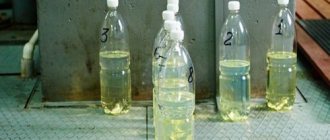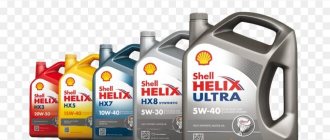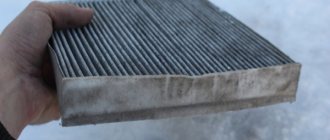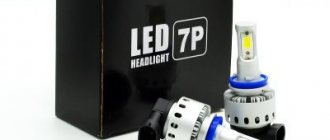November 09, 2021 Category: Useful information.
The operation of diesel engines in the CIS countries has its own characteristics. Sharp seasonal climate changes, fluctuations in average daily temperatures - all this forces owners to carefully prepare for the winter season. This includes choosing winter diesel fuel that will normally be pumped through the injection pump and fuel lines and will not turn into a gel in freezing conditions.
How does winter diesel fuel differ from summer diesel fuel?
From a chemist's point of view, diesel fuel is a mixture of paraffin, naphthenic and aromatic hydrocarbons and their derivatives.
Important. Diesel fuel (DF) is often called diesel fuel, this is a mistake. Diesel oil is diesel oil, a product of direct distillation of petroleum. The viscosity of diesel fuel is twice as high as that of diesel fuel, and the boiling point is also higher. Diesel oil is used for low-speed internal combustion engines of tractors and heavy equipment. If you fill a modern car with diesel oil, it will simply kill the high-precision fuel equipment of a diesel internal combustion engine.
There are three types of diesel fuel:
- summer - DTL
- winter - DTZ
- Arctic - DTA
If DTL begins to solidify already at -5°C, then DTL can withstand down to -20°C or less - it all depends on the composition and quality of the fuel.
- It is prohibited to use summer diesel fuel at temperatures below the permissible level; expensive fuel equipment can be damaged. It is better to switch to winter diesel fuel immediately with the arrival of the first frosts.
- But winter diesel fuel can be used in the warm season. True, this is impractical: in this case, the engine output will be lower, and the exhaust toxicity will be higher.
Summer and winter diesel fuel differ in density: when oil during the production of diesel fuel is distilled at a lower temperature than when producing diesel fuel. As a result, the density of winter diesel fuel is higher, it retains fluidity and hardens (waxes) not as easily as summer diesel fuel.
The main indicator of the quality of winter diesel fuel is its cetane number . It determines the maximum compression of fuel in an internal combustion engine cylinder at which self-ignition occurs. The higher this indicator, the calmer and smoother the fuel burns. The optimal indicator is from 45 to 55.
The balance between paraffins and aromatic hydrocarbons in the composition of “winter” diesel fuel
is also important If there are too many aromatic hydrocarbons, the exhaust becomes smoky and the engine is noisy and unstable. If there is a lot of paraffin, even at a temperature of -10°C the engine will not start without heating.
Composition of summer and winter fuel for diesel engines
Winter diesel fuel contains less paraffin than summer diesel fuel, and decompression additives are also added to the former. The fluid formula helps prevent freezing at low temperatures and maintain operating parameters that guarantee efficient combustion in the engine.
The increased content of paraffin and sulfur in summer brands increases the viscosity of the fuel in warm weather, but in the cold these additives crystallize and change the structure of the liquid. Fuel will not freeze like water, but difficulties will arise in starting the engine. In the worst case, the power system will become clogged, and you will have to disassemble the power unit and clean it, removing paraffin crystals.
Now you know how to distinguish winter diesel fuel from summer diesel fuel. By promptly changing the fuel used depending on the season, you can extend the life of the engine and save yourself from problems associated with fuel solidification.
Why does diesel fuel freeze in winter?
It's all about the presence of paraffins. As the temperature decreases, they crystallize in the fuel composition, and the viscosity of the diesel fuel increases. Thickened fuel has difficulty passing through the elements of the fuel system - the engine either does not start or starts with difficulty, after starting it operates unstably, troits, and stalls.
If the temperature continues to drop, paraffin clots begin to form in the diesel fuel, it turns into a gel and clogs the passage channels of the fuel filter. In this case, it is no longer possible to start the engine.
Owners solve the problem of freezing fuel in different ways: some use heating devices to heat the fuel in the tank, others add additives.
It is best to change (carry with you) the fuel filter before the cold weather arrives, check the glow plugs, drain the sediment from the fuel tank and refuel at proven gas stations with high-quality fuel.
Why can't you use summer fuel in winter?
The fact is that summer diesel fuel contains a large amount of sulfur and paraffin, which crystallize at subzero temperatures. Such diesel fuel will not be able to freeze completely, but its changed structure will make it impossible to start the engine, and the entire fuel system will require appropriate cleaning and removal of crystallizing paraffin molecules.
How to choose a winter diesel engine that will not freeze
Key indicators for winter diesel fuel are calculated based on atmospheric temperature:
- cloud point at which paraffin begins to freeze;
- maximum filterability temperature - fuel still passes through the filter, but you can no longer turn off the engine
- Application temperature is an indicator at which the fuel is guaranteed not to freeze.
In pure winter diesel fuel, all three temperatures must coincide. But in practice , all winter fuel supplied to gas stations is summer fuel with additives . And the greater the difference between the filterability and cloud point temperatures, the more additives this fuel contains.
Important. The quality of winter fuel can be checked right there at the gas station. You just need to drip fuel from the fuel supply hose onto a metal surface in cold weather (a coin will do). Summer diesel fuel will immediately freeze, while winter diesel fuel will remain fluid.
The most important indicator for a car owner is the maximum filterability temperature - PTF. This indicator can be influenced by adding various additives - antigels - to the fuel.
Important. Even if, through the use of anti-gel, the PTF was reduced, for example, from -10 to -20°C, the cloud point will still be 10°C higher than the application temperature.
To calculate the temperature range of the fuel, the owner needs to find out the cloud point of the diesel fuel at the gas station (it is indicated in the fuel passport) and add 10°C to it. This will be a real indicator of the temperature outside when the paraffin does not clog the fuel filter.
You just need to take into account not only the weather forecast, but also comfort - humidity, wind strength and direction, etc. So feel free to add +3-7 degrees below zero to the actual daily temperature.
Where and how to use diesel fuel
Diesel is used in:
- diesel internal combustion engines in vehicles;
- diesel heating boilers;
- electricity generators.
The fuel is widely used for land, air, rail and sea transport.
Domestic products are characterized by a high content of sulfur compounds. A high concentration of sulfur leads to oxidation, which leads to accelerated engine wear. Therefore, there is a general rule for all types of diesel fuel: you need to use high-quality motor oil designed specifically for diesel fuel.
Main performance characteristics of diesel fuel
Resistance to low temperatures is the main parameter of diesel fuel, which determines the conditions of its use and storage features.
Another main indicator of diesel fuel quality is the aforementioned cetane number. The higher its value, the more confidently one can judge the longer life of the internal combustion engine. The engine runs smoothly, detonation is eliminated, and the dynamics of the car are increased.
The ignition temperature indicator determines the degree of safety of using diesel fuel in internal combustion engines. The friction composition in diesel fuel determines whether the mixture will burn completely in the cylinders, the level of smoke and the degree of toxicity of the exhaust.
The density of diesel fuel determines how effective the supply of fuel through the channels of the fuel system, its filtration and spraying in the nozzles will be.
Sulfur content. Its absence in the composition makes the fuel too “fresh” - there is a lack of lubrication of the elements of the fuel equipment. However, increased sulfur content leads to premature corrosion on internal combustion engine parts, rapid accumulation of carbon deposits, and increased wear of the fuel injection pump.
The main characteristics of diesel fuel, especially in modern conditions, include the indicator of product purity. This is not only an extension of the life of components and elements of vehicles, but also maintaining environmental standards in places of industrial production.
Freezing point of summer diesel fuel
It is difficult to accurately calculate this range because many variables come into play. However, two key temperatures are known:
- The cloud point is when the paraffin wax just begins to fall out of the fuel.
- The pour point at which diesel fuel has so much gel that it no longer flows. This point is usually located slightly below the cloud point of the fuel.
For summer diesel fuel, the first temperature approximately corresponds to the range of -4...-6ºС, and the second -10...-12ºС (assuming a constant outside air temperature). More accurately, these temperatures are determined in laboratories, where other physical and mechanical characteristics of the fuel are also taken into account.
Is it possible to use winter diesel fuel in summer?
Fuel intended for use exclusively in winter will not solidify in summer, but its use is not recommended. Its distinctive features are the main “enemies” of internal combustion engines in the summer: sulfur and low viscosity.
Mercaptan sulfur is not removed with combustion products, but accumulates inside the fuel system, forming noticeable deposits. Over time, this leads to contamination of the system and its failure. Some parts become heavily clogged and break.
Low viscosity, which prevents fuel from freezing, does not provide sufficient lubrication to engine parts in summer. Therefore, rubbing functional units wear out much faster than when using summer fuel.
Winter diesel fuel can be used in summer, but only if there is no other choice.
When do sales of winter stamps begin?
Now you know at what temperature on average winter diesel fuel usually freezes, and why you should use it for your diesel engine in winter.
If we focus on Moscow and the Moscow region, then the regulated deadline here is October 1. It is from this day that gas stations begin to open pumps where you can fill a portion of winter fuel into the tank of your car.
Since the main feature of different brands of diesel fuel is its density, it is important to switch to diesel fuel in accordance with the temperature regime.
After October 1, the parallel sale of summer stamps continues due to unsettled temperatures, which may not yet fall below 0 degrees Celsius for some time.
In many ways, you should start from the standard temperature at which summer diesel fuel begins to thicken. This is -5 degrees Celsius. Based on actual weather conditions, summer compounds in some regions are poured until late autumn. And it also happens that with the beginning of winter there is still no need to switch to winter brands.
You need to do the following. If sales of winter brands have already begun, but the temperature has not dropped below the specified level, there is no need to rush to drain the old diesel fuel, clean the system and fill in new fuel.
Biodiesel
This type of diesel product deserves special attention. This is an innovative development of European engineers. The technology for the production of biological diesel fuel involves the use and processing of vegetable oils. The main difference between biodiesel and conventional diesel fuel brands is environmental friendliness. Complete disintegration of its combustion products without harmful consequences in the natural environment occurs within 30 days after entering the soil, water or atmosphere.
Biodiesel production
The governments of industrialized countries and international organizations specially created on this issue are now forced to act in the fight for the environment. By this time, new standards were introduced in the production and operation of biofuels.
Biodiesel is intended, first of all, for use in internal combustion engines of passenger vehicles, then for trucks and industry. Summer brands of high-quality diesel fuel are usually made on its basis. The cetane number of biodiesel is 58 units, and the combustion temperature is 100°C; it has excellent lubricating properties and a reduced percentage of CO2 emissions into the atmosphere. Thanks to the combination of such characteristics, product developers have provided car enthusiasts and enterprises with the opportunity to not only significantly increase the service life of internal combustion engines and reduce maintenance and repair costs, but also significantly reduce the risks of explosions and fires.
A feature of biological diesel fuel is the presence of vegetable and animal fats in the mass. The structure of biofuel is natural, and the product itself is the result of processing agricultural crops such as rapeseed, soybeans and other oil-containing plant species, and cattle fat. The distinctive characteristics of this type of diesel fuel are that it can be used as an additive to traditional types of fuel.
Biodiesel has special designations. For example, in the United States of America, biological fuel in the name includes the letter “B”, followed by a digital value indicating the percentage of bioadditive content in the total mass of the fuel. Cetane number not lower than 50 units.
Biodiesel is produced using a technology similar to the production of diesel fuel from oil. Today, there are brands of biodiesel not only for summer, but for off-season and winter conditions in temperate latitudes.
Summer diesel biofuel is used only at positive temperatures, intermediate grades - up to -10° below zero, winter biodiesel - up to minus 15-20°C. Frost resistance of winter grades is achieved through the use of special additives, originally developed to improve the properties of diesel fuel.
Application of different types of diesel fuel
Based on what was discussed earlier, we can conclude that there are 3 main types of diesel fuel. However, their application differs from each other. It is necessary to comply with certain conditions and rules in order not to harm your own car, and also not to face serious financial costs associated with repairing the fuel system and the engine itself.
- Summer stamps. They are suitable for vehicles running on diesel fuel at temperatures not lower than 0 degrees Celsius. These brands of diesel fuel are used in early autumn, summer and late spring. However, during frosts it is strongly not recommended to fill them. Typically, gas stations stop selling summer brands and switch to winter brands. But there are exceptions. Summer diesel fuel at -5 degrees Celsius begins to become cloudy, and freezes when the thermometer drops to -10 degrees. If such fuel is used in winter, there is a high probability of reducing the life of the engine and causing serious breakdowns.
- Winter stamps. These are specially developed types of diesel fuel that are used in all regions of Russia. Moreover, they are sold throughout the Russian Federation in winter, and in the north all year round due to constant low temperatures in these regions. There are different brands of winter fuel, differing in production technologies and additives used. Depending on this, the pour point can be from -20 to -30 degrees Celsius.
- Arctic stamps. The rarest and most expensive type of winter fuel. It is used mainly in those regions where very severe frosts are observed. It is not recommended to fill Arctic diesel fuel in the summer or use it in regions with a mild climate. The composition will become cloudy at -51 degrees, and will harden only at -55 degrees Celsius.
For each period of the year and certain temperature conditions there are special brands of diesel fuel. Therefore, it will be better and more correct if motorists start purchasing seasonal diesel fuel.
Main fuels for diesel engines
Beginners often forget about the main disadvantage of diesel fuel - its ability to freeze even in slight frost. In such a situation, the car will not start, and to solve the problem you have to use a whole range of measures to warm up the main elements and increase the temperature of the diesel fuel in the system. To prevent this, it is important to choose diesel fuel correctly and know its types and features. The main classes of diesel fuel include:
Summer diesel fuel
Its peculiarity is its liquid state at temperatures from “zero” degrees Celsius or more. The main parameters include:
- cetane number, usually 45 degrees Celsius or more;
- viscosity. At a temperature of 20-22 C it is 4-6 sq. mm/s;
- density. At a temperature of 20-22 C it is up to 850-860 kg/cubic meter;
- the temperature of complete freezing is from -10 degrees Celsius and below. In practice, such fuel can solidify earlier (from -3-5 degrees Celsius).
The main disadvantage of summer fuel is the appearance of moisture condensation inside the tank, moisture peeling off and its accumulation in the lower part of the tank. This feature causes a lot of problems for car enthusiasts:
- in summer, a water “plug” can block the fuel system and lead to malfunctions;
- in winter, moisture freezes and immobilizes the car even with minimal frost. That is why, even before the onset of cold weather, summer diesel fuel must be completely drained from the tank and replaced with a higher-quality winter composition.
Winter diesel fuel
This type of diesel fuel is most popular in Russia. At the same time, we must not forget about its main feature - freezing when it reaches 30 degrees below zero. For regions with harsh winters, such fuel for diesel engines is not the best option. The main characteristics of winter diesel fuel include:
- cetane number – from 44-45;
- density – up to 830-840 kg/cubic meter;
- viscosity - from 1.9 to 4.9-5.0 sq. mm/s.
Viscosity and density parameters are given for a temperature of 20-22 degrees Celsius.
Arctic
This is the best option for areas where the outside temperature can drop well below thirty degrees. This diesel fuel can adequately withstand frosts down to -50 degrees Celsius, which is significantly lower than that of its competitors. The main characteristics of Arctic fuel include:
- cetane number – from 40;
- density – up to 820-830 kg/cubic. meter;
- viscosity – from 1.5 to 4.0 sq. mm/s.
The parameters of viscosity and density, as in previous cases, are given for a temperature of 20-22 degrees Celsius.
Video: How to start a frozen diesel engine?!
Tips and tricks
Some experienced drivers use the following method to make starting a diesel engine easier in winter:
- First, the combustion chamber is heated by the glow plugs a couple of times;
- then about 10 ml is poured into the air filter housing from a syringe. gasoline;
- then the engine can be started;
Let us immediately note that this decision is an emergency measure, that is, this method cannot be used regularly. Starting with gasoline vapors leads to increased loads, which significantly reduces engine life.
Also, owners of diesel cars that operate in regions with fairly severe winters can be advised to install various pre-heaters (fuel filter and power system heater, engine oil heater in the sump, Webasto or Gidronik type engine pre-heater, etc.)
It is also recommended to insulate the engine compartment and engine separately. A car blanket is well suited for this, as it retains heat and prevents the internal combustion engine from cooling quickly. It would also be a good idea to insulate the radiator of the cooling system. For these purposes, you can use various solutions, the simplest of which is to install a thick cardboard “damper”.
Finally, we note that it is not recommended to warm up a diesel engine for a long time at idle, since this type of engine warms up only when driving under load. This means that after 3-5 minutes of starting work, you need to drive a diesel car, but drive for the first 5 km. should be smooth, without a significant increase in speed, sudden starts and braking, driving in high gears, etc.
Using winter varieties in summer
Another pressing issue is the use of diesel fuel in summer, which is designed according to its characteristics for use in frost conditions.
It is really important to know exactly whether diesel fuel, sold as winter fuel, can be filled into the tank in the summer or warm spring.
As mentioned earlier, in winter, summer diesel fuel thickens and can freeze. Because of this, it is not recommended to fill it during this period. This is dangerous for the engine and fuel system.
But in the summer, winter fuel will definitely not freeze. Therefore, many are confident that it can be safely used, and the engine will not encounter any side effects. This statement is erroneous. In theory, it is possible to fill winter stamps in summer. But in practice this is strongly not recommended.
Here the question is no longer about freezing. Cold grades of diesel fuel contain components that, in warm weather conditions, become extremely harmful and dangerous for a diesel engine. We are talking about sulfur and such a property as viscosity. Winter brands are low-viscosity, that is, they are less thick than their summer counterparts.
Sulfur, or rather mercaptan sulfur, will not be removed along with combustion products. Instead, it will gradually begin to accumulate inside the fuel system. This creates dangerous deposits inside. Over time, the car owner will be faced with the problem of contamination of the fuel lines and the entire system, which as a result may completely fail. Some elements are particularly sensitive to such contaminants, which is why they are the first to become clogged and break.
If we talk about low viscosity, which is used to prevent winter diesel fuel from freezing, in warm weather it does not provide the engine elements with the necessary lubrication efficiency. As a result, the rubbing surfaces will wear out more actively.
You can only fill your car with winter types of diesel fuel if you simply have no other choice. There is no opportunity to purchase and fill special summer stamps. But at the first need, you should make the transition according to the scheme proposed above. The longer a car is operated on off-season fuel, the higher the likelihood of encountering unpleasant consequences.
Diesel engine does not start in winter
Diesel does not start when cold because summer diesel fuel thickens at sub-zero temperatures, turning into a waxy gel in the fuel system. The resulting paraffin crystals clog the diesel fuel filter. Heating the fuel system, replacing the fuel filter, or adding a special additive to the fuel can help start a diesel engine. The penetration of water into a diesel engine can disable the high-pressure fuel pump. Water in the tank appears when condensation forms in cold weather. Water and other impurities are retained in the coarse filter. If a diesel engine does not start in cold weather, the cause may be frozen water in the filter. To prevent the concentration of water in the fuel system, you can add a small amount of alcohol or a special additive - a dehydrator - to the tank. Air in the fuel line after inactivity leads to a drop in pressure. The most common damage and loss of elasticity of fuel hoses, rubber seals, rings, and seals occurs. The air is removed by pumping the injection pump and the fuel line. At low temperatures, the frequently used 15W-40 engine oil becomes thick and can make starting a diesel engine difficult. Most problems with the starter and battery appear in the cold season. Diesel has a reinforced starter, since starting requires a high degree of compression of diesel fuel. At sub-zero temperatures, the battery noticeably loses its charge. A diesel engine starts poorly when cold, when a weak battery cannot crank the crankshaft at the required frequency to create pressure. With an undercharged battery and a faulty starter, it is almost impossible to start a diesel engine.











